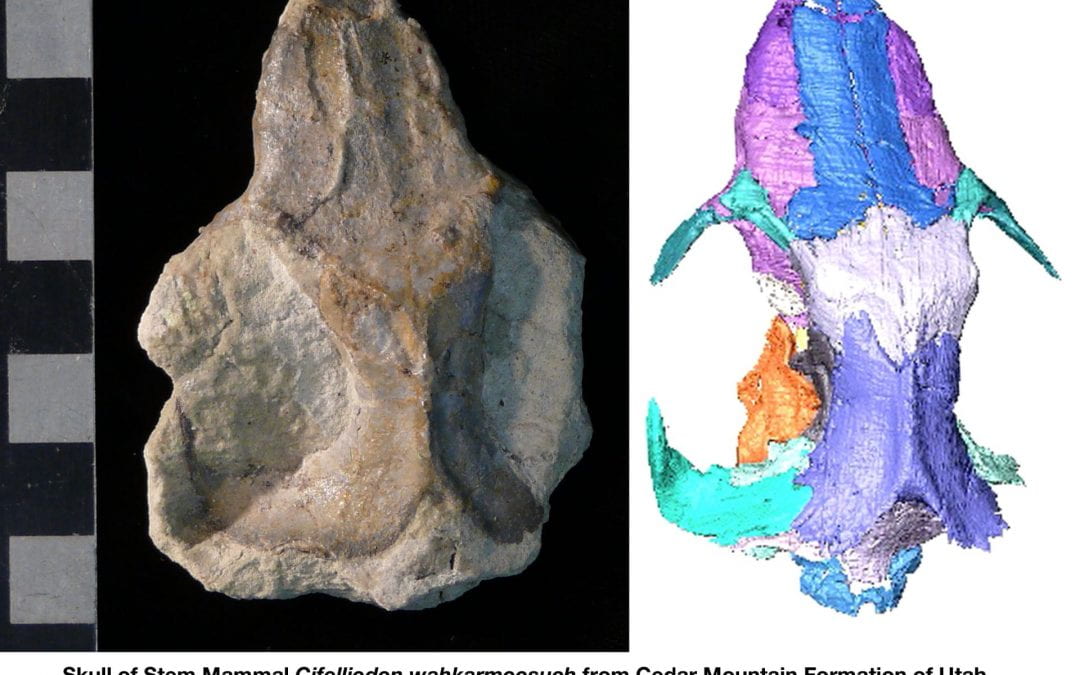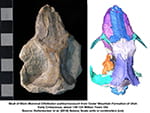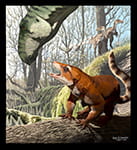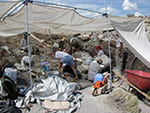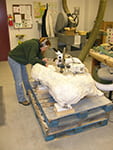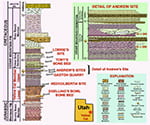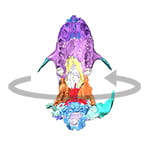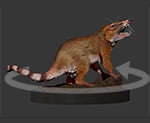Press Release
Utah fossil reveals global exodus of mammals’ near relatives to major continents
By Matt Wood
A small fossil is evidence that Earth’s ancient supercontinent, Pangea, separated some 15 million years later than previously believed
A nearly 130-million-year-old small fossilized skull found in Utah is an Earth-shattering discovery in one respect.
The fossil is evidence that the super-continental split likely occurred much more recently than scientists had previously thought and that a group of reptile-like mammals that bridge the reptile and mammal transition experienced an unsuspected burst of evolution across several continents.
“Based on the unlikely discovery of this near-complete fossil cranium, we now recognize a new, cosmopolitan group of early mammal relatives,” said Adam Huttenlocker, lead author of the study and assistant professor of clinical integrative anatomical sciences at the Keck School of Medicine of USC.
The study, published in the journal Nature on May 23, updates the understanding of how mammals evolved and dispersed across major continents during the age of dinosaurs. It suggests that the process of separation of the ancient landmass Pangea continued much longer, and the full divide of Laurasian and Gondwana landmasses was completed about 15 million years later, than previously thought. The mammal migration and dispersal and those of their close relatives continued during the Early Cretaceous (145-101 million years ago).
Paleontologists had once believed that the primitive precursors to mammals were anatomically similar, ecological generalists. “But now we know mammal precursors developed capacities to climb trees, to glide, to burrow into the ground for subterranean life, and to swim,” said Zhe-Xi Luo, senior author of the study and professor of organismal biology and anatomy at the University of Chicago. “With this new study, we also know that they dispersed across from Asia and Europe, into North America, and further onto major southern continents.”
The study reveals that the early mammal precursors migrated from Asia to Europe, into North America and further onto major southern continents, Luo said.
A new species
Huttenlocker and his collaborators at the Utah Geological Survey and UChicago named the new species Cifelliodon wahkarmoosuch.
Found in the Cretaceous beds in eastern Utah, the fossil is named in honor of famed paleontologist Richard Cifelli. The species name, “wahkarmoosuch,” means “yellow cat” in the Ute tribe’s language in respect of the area where it was found.
Scientists used high-resolution computed tomography (CT) scanners to analyze the skull.
“The skull of Cifelliodon is an extremely rare find in a vast fossil-bearing region of the Western Interior, where the more than 150 species of mammals and reptile-like mammal precursors are represented mostly by isolated teeth and jaws,” said James Kirkland, study co-author in charge of the excavation and a Utah State Paleontologist.
With an estimated body weight of up to 2.5 pounds, Cifelliodon would seem small compared to many living mammals, but it was a giant among its Cretaceous contemporaries. A full-grown Cifelliodon was probably about the size of a small hare or pika (small mammal with rounded ears, short limbs and a very small tail).
It had teeth similar to fruit-eating bats and could nip, shear and crush. It might have incorporated plants into its diet.
The newly named species had a relatively small brain and giant “olfactory bulbs” to process sense of smell. The skull had tiny eye sockets, so the animal probably did not have good eyesight or color vision. It possibly was nocturnal and depended on sense of smell to root out food, Huttenlocker said.
Supercontinent existed longer than previously thought
Huttenlocker and his colleagues placed Cifelliodon within a group called Haramiyida, an extinct branch of mammal ancestors related to true mammals. The fossil was the first of its particular subgroup – Hahnodontidae – found in North America.
The fossil discovery emphasizes that haramiyidans and some other vertebrate groups existed globally during the Jurassic-Cretaceous transition, meaning the corridors for migration via Pangean landmasses remained intact into the Early Cretaceous.
Most of the Jurassic and Cretaceous fossils of haramiyidans are from the Triassic and Jurassic of Europe, Greenland and Asia. Hahnodontidae was previously known only from the Cretaceous of northern Africa. It is to this group that Huttenlocker argues Cifelliodon belongs, providing evidence of migration routes between the continents that are now separated in northern and southern hemispheres.
“But it’s not just this group of haramiyidans,” Huttenlocker said. “The connection we discovered mirrors others recognized as recently as this year based on similar Cretaceous dinosaur fossils found in Africa and Europe.”
##
The study, “Late-surviving stem mammal links the lowermost Cretaceous of North America and Gondwana,” was supported by the U.S. federal government and the State of Utah. The specimen was found on U.S. Department of the Interior’s Bureau of Land Management lands and is held in the public trust at the Natural History Museum of Utah, Salt Lake City, where it is on display. Additional authors include David Grossnickle and Julia Schultz from UChicago.
Fact box
Name: Cifelliodon wahkarmoosuch
Skull Length: 3 inches (7.6 centimeters)
Weight: 2.5 pounds (1.1 kilograms)
Diet: Leafy and fleshy vegetation
Appearance: Buck teeth, shallow snout, downturned face
Lifestyle: Possibly nocturnal
Skill: Heightened sense of smell
Authors and Contacts
Prof. Adam K. Huttenlocker
Department of clinical integrative anatomical sciences
The Keck School of Medicine
University of Southern California
Email: ahuttenlocker@gmail.com
Dr. James I. Kirkland
Utah Geological Survey
Email: jameskirkland@utah.gov
Prof. Zhe-Xi Luo
Department of Organismal Biology and Anatomy, University of Chicago
Chicago, IL, USA
Tel: 773.702.7816
Email: zxluo@uchicago.edu
About the University of Chicago Medicine & Biological Sciences
The University of Chicago Medicine & Biological Sciences is one of the nation’s leading academic medical institutions. It comprises the Pritzker School of Medicine; the University of Chicago Biological Sciences Division; and the University of Chicago Medical Center. Twelve Nobel Prize winners in physiology or medicine have been affiliated with the University of Chicago Medicine.
News: uchicagomedicine.org
Twitter: @UChicagoMed, @ScienceLife
Facebook: /UChicagoMed
Images
Attention: Artwork and photographs downloaded from here are for media use only.

